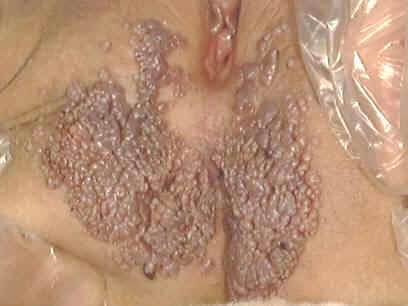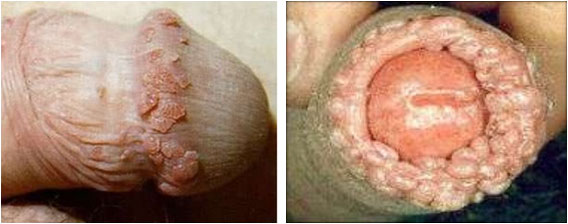Genital warts are only one of the four different types of warts namely the common wart, plantar warts, flat warts, and venereal (genital) warts. Warts are known as a skin disease, and very common. Most people will at some stage or another have a wart somewhere on their body. These warts, however, are also known as a sexually transmitted disease (STD) or venereal disease and are scientifically known as condyloma acuminate, or venereal warts. Statistics show an increase in genital warts transmission. Different strains of the human papillomavirus (HPV) cause different types of warts. HPV types 6 and 11 are the main cause of about 90% of venereal warts. The warts are generally not considered cancerous, except for those warts caused by the HPV types 16, 18, 31, and 45. These high-risk HPV types are also referred to as oncogenic. Cervical cancer believed to be caused by HPV in all cases.
As with planters warts, venereal warts are very contagious and are caused by spreading the infection through sexual contact which involves the vagina, anus, or mouth. The warts are found in the anal and private parts of both males and females. These warts can occur at any age, and both sexes are affected by them. Since the warts are very contagious, a person can get infected from a single sexual encounter with someone who has been infected with warts, and protected intercourse does not guarantee a person will not get infected. The infection might not be visible for months due to the fact that they are generally painless and are invisible due to the location, i.e. inside the anus or vagina, on the cervix inside the body. Visible venereal warts are commonly found on the skin near the anus or vagina in women; in men, the areas are the penis shaft, scrotum, groin area, thighs, and also around the anus.
What Do Genital Warts Look Like In Women
How do you know if you have genital warts? The pictures of genital warts in women and warts on the penile shaft in men indicate how severe these warts can get if not treated. The pictures of vaginal warts below show how bad the infection can get if not treated. Other pictures show what HPV warts on men typically look like. Some people have found warts to occur on the lips, inside the mouth, throat, and tongue, the result of oral sex. Factors that can contribute to suffering from these warts include, but is not limited to pregnancy, weakened immune system, use of alcohol and tobacco, sexual activity at a young age, and having multiple sex partners.
Page Contents
Genital warts: what are the symptoms?
Visible grey or flesh-colored cauliflower-shaped growths in and around the vagina, anus, on the penis, and to a lesser extent on the lips. Are genital warts painful and do they itch? They are generally painless, and small, they can however also be large, ugly, itchy, and painful. As can be seen in some of the venereal warts pictures, the growths can become huge masses, and quite quickly too. Warts on the penile shaft of men are very common.

Another symptom associated with venereal warts is the increase in dampness and moisture in the infected areas. In women, vaginal fluid excretion increases; they can also experience bleeding and pain during or after intercourse when the warts are located inside the cervix or vagina. A typical symptom in men is tiny papules on the shaft of the penis.

The warts are generally painless, and itching in the affected area is often mistaken for a simple rash. A burning sensation in the anal and venereal areas is another symptom experienced. In severe cases, warts could spread to the anal area even if no anal sex took place.
Genital warts treatment
Women who had venereal warts need to have pap smears done regularly; also if their partner had them. Vaccination is advised for women and girls ages 9 – 26, even though the effect is lessened somewhat in preventing cervical cancer if they have already had an infection with high-risk HPV.
In conclusion:
The only foolproof method to prevent these warts is by refraining from any sexual intercourse. Since this option is not a viable one, prevention is possible. Using a condom (not full protection, but reduces risk), and sticking to only one sexual partner you know is disease-free, can lessen the chances of contracting a sexually transmitted disease (STD). Even without any visible warts or symptoms, people having intercourse can infect one another with HPV, causing venereal warts.